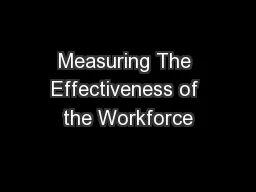

AS Business Studies Unit 2 Aims and Objectives Aim Understand how to measure the effectiveness of the workforce Objectives Define workforce performance Calculate workforce performance measures ID: 549167
Download Presentation The PPT/PDF document "Measuring The Effectiveness of the Workf..." is the property of its rightful owner. Permission is granted to download and print the materials on this web site for personal, non-commercial use only, and to display it on your personal computer provided you do not modify the materials and that you retain all copyright notices contained in the materials. By downloading content from our website, you accept the terms of this agreement.
Slide1
Measuring The Effectiveness of the Workforce
AS Business Studies
Unit 2Slide2
Aims and Objectives
Aim:
Understand how to measure the effectiveness of the workforce.
Objectives:
Define workforce performance
Calculate workforce performance measures
Analyse
workforce performance measuresSlide3
Starter
How could a business measure the effectiveness of it’s workforce?Slide4
Workforce Performance
Methods of measuring the effectiveness of employees including labour productivity, staff turnover and absenteeism.Slide5
Labour Turnover
Percentage of workforce who leave in a given period of time.
Voluntary
Involuntary – redundancies/dismissal
UK between 16%-18%
(Number of leavers per year / average number of employees per year) x 100Slide6
Calculating Labour Turnover
Calculate labour turnover rate for each year
What do the figures suggest about the introduction of the new training programme and bonus scheme?
Make a list of what the costs of labour turnover might beSlide7
Labour Turnover Costs
Additional
recruitment
costs
Lost
production
costs
Increased
costs of training replacement
employees
Loss
of know-how and customer
goodwill
Potential
loss of sales (e.g. if there is high turnover amongst the sales
force)
Damage
that may be done to morale and productivity (an intangible cost)Slide8
Labour Turnover Causes
Task:
Brainstorm causes of labour turnover.Slide9
Labour Turnover Causes
Inadequate
wage levels leading to employees moving to
competitors
Poor
morale and low levels of motivation within the
workforce
Recruiting
and selecting the wrong employees in the first place, meaning they leave to seek more suitable
employment
A
buoyant local labour market offering more (and perhaps more attractive) opportunities to employeesSlide10
Labour Productivity Measure 1
Output per employee
Manufacturing businesses easy to measure
Can be hard to measure service business
Total value of output / total number of employeesSlide11
Labour Productivity Measure 2
Labour cost per unit of output
(Total labour costs / total output) x 100
An increase in labour productivity will reduce labour cost per unit of output and improve competitiveness Slide12
Labour Productivity Measure 3
UK Productivity
Used to compare UK internationally
Total UK output / Total UK hours workedSlide13
Calculating Labour Productivity
Calculate the labour productivity per year using the output per employee formula.
Calculate the labour productivity using the labour costs per unit of output method.
What do these figures suggest about the effectiveness of the workforce?Slide14
Measuring the effectiveness of the workforce Lesson 2Slide15
Why calculate labour productivity?
Business can see if using resources efficiently.
If output per employee is falling, there is room to improve efficiency.
Figures do not provide a solution, but allow identification and investigation of problems.Slide16
Absenteeism
Number of working days lost as a result of an employee’s deliberate or habitual absence from work.
(Average number of staff absent on one day/
total number of staff) x100Slide17
Calculating Absenteeism
Calculate the percentage absenteeism rate for years 1-4.
Describe the trend you observe from the answers in question 1. How might you explain this trend?Slide18
Why Calculate Absenteeism?
High or rising abs. represents costs to business.
Requires investigation and solutions which focus on improving job satisfaction and motivation to ensure workers enjoy their work and will only be absent if very ill.
Cost UK £11.6bn p.a.
On average 2.6% of total business costsSlide19
Exam Question
June 2009 Question 2a